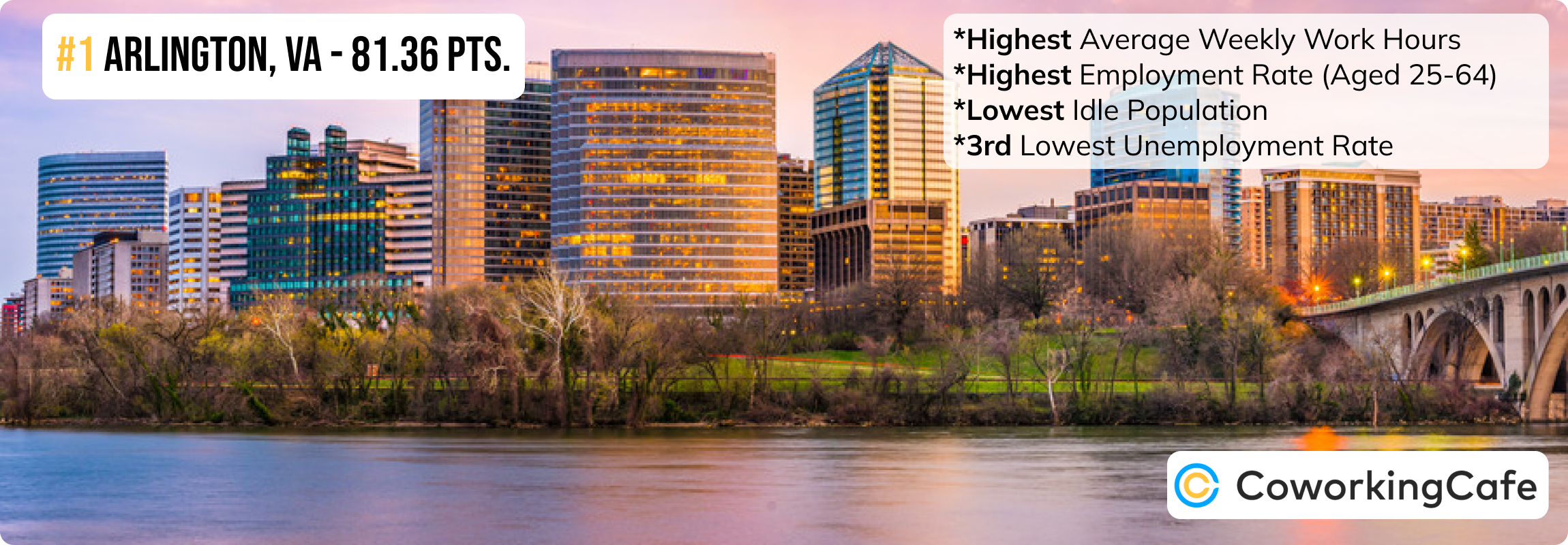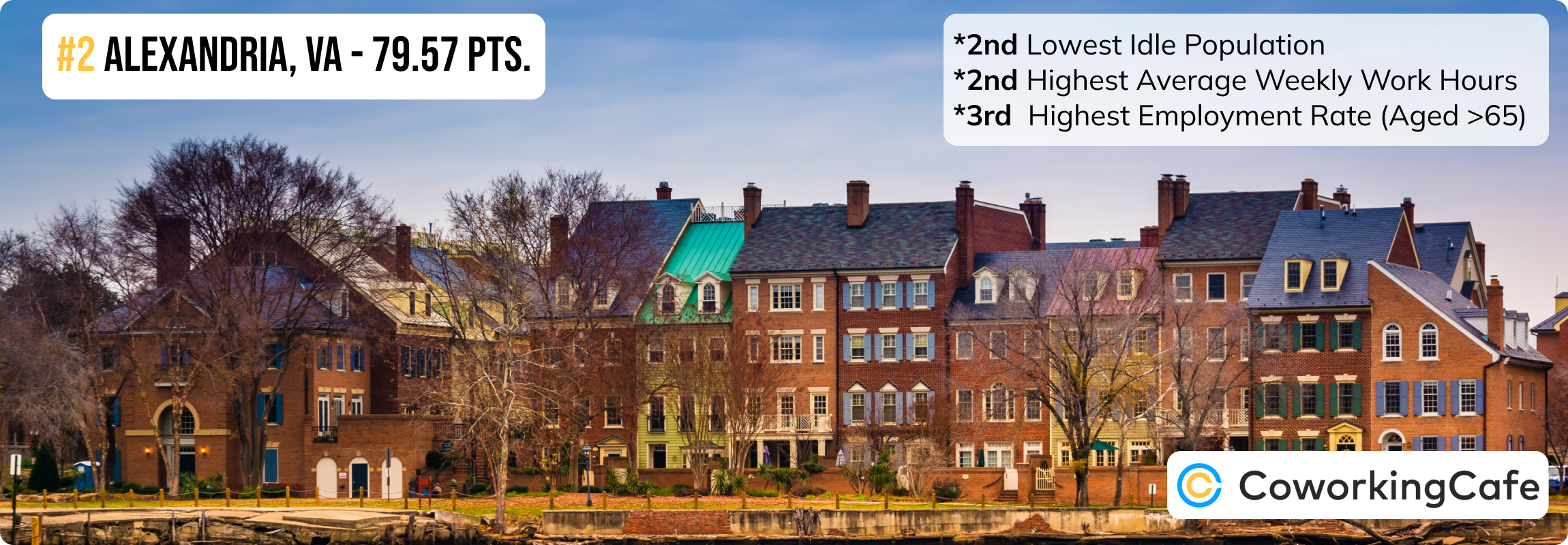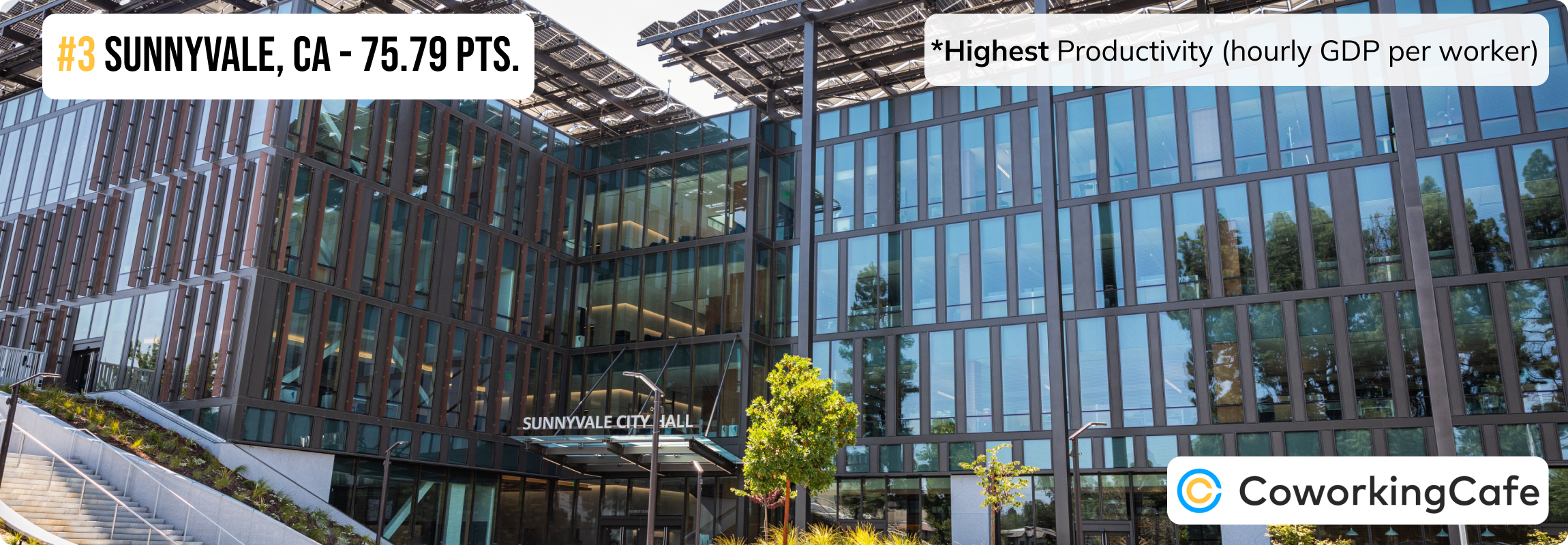Key Takeaways
- Arlington, VA emerged as the hardest-working U.S. city with the lowest share of idle population and highest employment rate in its active age group, followed by neighboring Alexandria, VA.
- Sunnyvale, CA rounded out the podium, taking the pole position for its highest productivity, joined by two metro-area neighbors in the top 20.
- The Dallas-Fort Worth metroplex in Texas took 5 positions in the top 20, led by Carrollton at #4, followed by Frisco, Irving, Dallas and McKinney.
- Sioux Falls, SD was the hardest-working Midwestern city with a well-rounded performance across all work, productivity and efficiency metrics analyzed.
- Cambridge, MA was the top contender from the Northeast, earning the highest score for overall employment rate and density of coworking spaces.
In the journey toward prosperity, a city’s most valuable asset is its armada of skilled and motivated workers who not only work hard, but also operate with maximum efficiency — its workforce. With that in mind, this article delves into America’s most hardworking cities, identifying the locations where a strong work culture spans all age groups and helps leverage the best of what workers bring to the table — from the vigor of youth to the expertise of seasoned professionals.
However, we don’t stop at traditional work metrics like hours worked and employment rates. Instead, we analyze the nuances of employment, considering the idle population — those who are not contributing to the local economy or actively seeking employment. Our comprehensive approach reveals the true champions of hard work, cities where a strong work culture propels economic progress.
DFW, D.C. & the Bay Area Stand Out Among the National Distribution of Hardworking Cities
Find below a detailed breakdown of the leading 20 cities where productivity and efficiency reign supreme. Each of these locations ranked high across different relevant metrics, like the average weekly work hours, employment rates and productivity levels, among others.
1. Arlington, VA
 Arlington, VA emerged as a model of both productivity and efficiency, topping our ranking with an impressive overall score of more than 81 points. Here, the average Arlington worker puts in around 41 hours every week, and the city’s hard work was further emphasized by the employment rate in the 25 to 64 age group (exceeding 85%) — as well as its low idle population of just more than 11% — to lead the nation in all three metrics. Furthermore, the city’s 2.8% unemployment rate (the third-lowest in the country) indicates a well-matched workforce and underscores Arlington’s commitment to efficiency.
Arlington, VA emerged as a model of both productivity and efficiency, topping our ranking with an impressive overall score of more than 81 points. Here, the average Arlington worker puts in around 41 hours every week, and the city’s hard work was further emphasized by the employment rate in the 25 to 64 age group (exceeding 85%) — as well as its low idle population of just more than 11% — to lead the nation in all three metrics. Furthermore, the city’s 2.8% unemployment rate (the third-lowest in the country) indicates a well-matched workforce and underscores Arlington’s commitment to efficiency.
Additionally, the city also takes pride in having one of the highest employment rates of more than 26% in the 65+ age group, thereby harnessing the skills and experience of its older workforce. The city also scored in the top 10 nationwide for its efficiency indicators, which were spearheaded by its 27% rate of working from home and more than 10 coworking spaces per 100,000 residents. But, while Arlington embraces remote work, commuters face a nearly 28-minute commute time, trailing even cities that are notorious for their congested roads, like Atlanta and Houston.
2. Alexandria, VA
 Next door, Alexandria, VA proved to be a true hub of productivity by securing the second spot in our ranking with a total score just shy of 80 points. In this case, the city’s dedication to hard work is clearly demonstrated in its average work week of just less than 41 hours, placing it second in the nation. This commitment was further reflected in Alexandria’s low idle population of less than 12% in the active age group, as well as its third-highest employment rate among older adults at more than 30%. Notably, the latter was only outdone by Cambridge, Mass., and Carrollton, TX. Moreover, Alexandria’s 3.2% unemployment rate is also the third highest on our list.
Next door, Alexandria, VA proved to be a true hub of productivity by securing the second spot in our ranking with a total score just shy of 80 points. In this case, the city’s dedication to hard work is clearly demonstrated in its average work week of just less than 41 hours, placing it second in the nation. This commitment was further reflected in Alexandria’s low idle population of less than 12% in the active age group, as well as its third-highest employment rate among older adults at more than 30%. Notably, the latter was only outdone by Cambridge, Mass., and Carrollton, TX. Moreover, Alexandria’s 3.2% unemployment rate is also the third highest on our list.
While Alexandria didn’t rank as high in the efficiency category as Arlington, mainly because of its 30-minute average commute time, it’s worth noting that the city has more than 15 coworking spaces per 100,000 residents — a 50% higher density to slightly outperform even Washington, D.C.
3. Sunnyvale, CA
 Sunnyvale, CA shined as a beacon of productivity to capture the third spot in our ranking with almost 76 total points. Silicon Valley’s effect on the local economy is undeniable with the $195 per hour of value created per worker based on the GDP of the San Jose-Sunnyvale-Santa Clara, Calif., metro area. This pushed Sunnyvale and San Jose to third and 17th places in our ranking, respectively. However, the data also showed that the area’s economic momentum was also matched by Sunnyvale’s outstanding adoption of remote work as one in four residents works from home — a clear sign of a mindset that prioritizes efficiency.
Sunnyvale, CA shined as a beacon of productivity to capture the third spot in our ranking with almost 76 total points. Silicon Valley’s effect on the local economy is undeniable with the $195 per hour of value created per worker based on the GDP of the San Jose-Sunnyvale-Santa Clara, Calif., metro area. This pushed Sunnyvale and San Jose to third and 17th places in our ranking, respectively. However, the data also showed that the area’s economic momentum was also matched by Sunnyvale’s outstanding adoption of remote work as one in four residents works from home — a clear sign of a mindset that prioritizes efficiency.
Speaking of efficiency, Sunnyvale was one of the prime examples of working smart: Most of its contributions to the area’s prosperity are being carried by a highly active, working-age population with an employment rate of more than 81% in the 25 to 64 age bracket. Granted, on the two extremes, it was more moderate, ranking in the middle of the field when it came to the younger and older workforces. That suggests a strong focus on higher education and an above-average financial stability among retirees. Otherwise, in terms of its idle population and unemployment trends, Sunnyvale is at the low end of the list with rates of 16.5% and 4.1%, respectively.
4. Carrollton, TX
Ranking fourth overall, Carrollton, TX boasted the third-highest score nationwide in the work category. This was largely due to the Dallas suburb’s active older adults, who secured second place in this subcategory with an impressive employment rate of more than 32% — just half a percentage point below Cambridge, MA. What’s more, Carrollton demonstrated exceptional employment rates among its working-age group, standing tall at 83%. Plus, with an average workweek of just more than 40 hours, Carrollton’s workforce exemplifies dedication and resilience in their professional lives.
5. San Francisco, CA
On par with Carrollton in terms of average weekly work hours, San Francisco, CA is certainly one hard-working city. But, more important, the metropolitan area’s impressive $147 of value created by each worker every hour also placed it among the most productive. The city also boasted a robust employment landscape — particularly among its young workers — with a striking 54% employment rate among those aged 16 to 24. Likewise, with more than 23% working from home and an idle workforce of less than 16%, San Francisco also excelled when it came to work flexibility and efficiency.
6. Sioux Falls, SD
The hard-working residents of Sioux Falls, SD earned their city a place among the heavy-hitters by outranking many large coastal markets. Specifically, South Dakota’s favorable tax climate and a solid local infrastructure have created an attractive business environment for industries from biomedical to retail, health care, finance and manufacturing. Accordingly, the city was one of the most consistent high scorers.
For instance, it earned top spots in two subcategories — the lowest unemployment rate nationwide at 2.3%, as well as its enviable, less-than-17-minute commute time. Furthermore, garnering the fourth-highest work score nationwide, the city was also on the podium for its employment rate in all age groups with the exception of the older adults’ category, but even then it was still in the top 10. In fact, the average work week of just above 39 hours was the only metric where Sioux Falls lagged slightly behind most top-performers.
7. Santa Clara, CA
The second Silicon Valley hub on our list, Santa Clara, CA shared the top spot on the productivity chart with its neighboring cities of Sunnyvale and San Jose. Here, the metropolitan area’s staggering $195 hourly value created per worker was just one factor that propelled Santa Clara into the top 10. Embracing modern work dynamics, the city also boasted one of the highest rates of remote work with nearly 22% of its workforce telecommuting. This commitment to adaptability — coupled with an 81% employment rate among its active age group — underscored Santa Clara’s role as a catalyst for technological innovation and economic growth.
8. Scottsdale, AZ
In the heart of the Sonoran Desert, Scottsdale, AZ shined as a paragon of work efficiency by earning the best efficiency score out of all of the cities on our list. Even at the national level, it was only outdone by Bellevue, WA. With an average work week of nearly 41 hours, the city ranked third among the top performers nationwide, thereby reflecting its workers’ commitment to productivity. Furthermore, Scottsdale’s young workforce was another key to its economic vitality with nearly 62% actively contributing to the local economy for the third-highest employment rate on our list among those aged 16 to 24. And, with a swift average commute time of just more than 21 minutes, Scottsdale exemplifies the synergy between efficiency and quality of life.
9. Cambridge, MA
With a diverse workforce and a vibrant startup culture, Cambridge, MA stands as a testament to the power of collaboration in driving economic prosperity. With one in four active residents working from home and a well-developed infrastructure with an impressive 19 coworking spaces per 100,000 residents further encouraging remote labor, the city secured the second-highest work efficiency score among our top 20 cities. However, beyond the simplified work logistics, Cambridge also stood out for its productivity with each worker creating $108 of value per hour, on average, (based on the metro-level GDP) in almost 39 hours per week.
10. Overland Park, KS
Rounding out the top 10, Overland Park, KS emerged as a stronghold of workforce participation by boasting the second-highest employment rate in the junior (16 to 24 years), and third-highest in the working-age (25 to 64 years) bracket. The robust 65% and 84% employment rates, respectively — as well as the 3.2% unemployment rate — cemented Overland Park’s reputation as a thriving economic center in the heart of Kansas.
11. Seattle, WA
Back on the West Coast, Seattle, WA represented the Pacific Northwest on the list with its strong culture of innovation and productivity. Namely, its employment rate in the active age group of more than 83%; the 4.2% unemployment rate; and its low idle population rate among working-age residents at less than 15% placed it among the most vigorous local economies. At the same time, Seattle also earned the third-highest productivity score (thanks to the metro’s workers creating $122 of value per hour), as well as the second-highest rate of remote work among our top 20 cities at 27% to finish neck and neck with Arlington, VA.
12. Denver, CO
In the Rocky Mountains, Denver, CO boasted one of the lowest rates of idle workforce at a hair above 15%, as well as a robust employment rate reaching more than 81% among its active age group. While the Colorado capital averaged slightly below the 40-hour threshold set by the five-day, 9 to 5 routine in terms of work hours, the data suggested a strong efficiency-driven mindset with a solid (almost 21%) adoption of remote work and nearly 14 coworking spaces per 100,000 residents.
13. Frisco, TX
In the vibrant Texas landscape, Frisco, TX showcased dedication and resilience among its workforce with a 3.9% unemployment rate and an average workweek of just more than 40 hours. The Dallas suburb also had the third-highest efficiency score among our top 20 cities, thanks to an outstanding rate of remote work of almost 30%.
14. Austin, TX
As the lone star of Texas on our list beyond the Dallas-Fort Worth-Arlington metroplex, Austin, TX earned its place among the hardest-working cities with one of the highest employment rates among its active age group at more than 82%. Additionally, the city’s 4.4% unemployment rate indicates a steadfast commitment to workforce engagement.
15. Irving, TX
Back in the heart of the DFW metroplex, Irving, TX stood out for having one of the highest rates of employment among older adults at nearly 27%. That’s in addition to a moderate, 4.1% unemployment rate, thereby showing a culture of inclusivity and an environment of opportunity for all age demographics.
16. Washington, D.C.
While Washington, D.C. had above-average employment rates across all age groups; a relatively low rate of idle population (just more than 16%); and one of the longest average work weeks at more than 40 hours, it was its efficiency metrics that made it stand out more. Although these, too, were overshadowed by the 30-minute commute (the second-longest within the top 20), one in four workers in the nation’s capital were telecommuters or hybrid workers, thus escaping the hassle of the long morning and afternoon rides.
The city also has a well-developed coworking infrastructure with nearly 15 flex offices per 100,000 workers, which offers plenty of opportunity to cut corners. Of course, the $96 hourly average value created per worker was also among the highest on the East Coast, which likewise contributed to its nearly 67-point overall score.
17. San Jose, CA
Much like its higher-ranking suburbs, San Jose, CA emerged as one of the more result-oriented cities in terms of work trends. More precisely, the San Jose-Sunnyvale-Santa Clara metropolitan area’s collective $195/hour of value created per worker was not only the highest in the nation, but also in a league of its own, dwarfing even the runner-up (the San Francisco-Oakland-Berkeley metro area’s $147 figure). Plus, the fact that the local workforce produced the record GDP with low involvement from the extremes of the age spectrum (at least compared to most high-scorers) — and in the shortest average workweek out of the top 20 at just more than 38 hours — speaks volumes of the city’s productivity.
18. Stamford, CT
Stamford, CT showcased workforce inclusivity with one of the highest employment rates seen among active older adults at nearly 26%. Similarly, the city’s high employment rates across the other age groups and its idle population of just more than 15% further demonstrated its commitment to attracting and retaining talent. Not to be outdone, the hourly value created per worker in the Bridgeport-Stamford-Norwalk metro area also averaged in the three digits.
19. Dallas, TX
With one of the longest average workweeks at almost 41 hours and a minimal commute time of less than 27 minutes, Dallas, TX exemplifies efficiency and productivity. Positioned as a center of economic activity, Dallas showcases resilience and opportunity to set a high standard for workforce engagement and economic vitality.
20. McKinney, TX
Rounding out the top 20, McKinney, TX was the fourth Dallas suburb on our list. With a low, 3.7% unemployment rate and consistently high scores across the other metrics, the city further reinforces the DFW area’s reputation of as one of the great hard-working American hubs.
Methodology
CoworkingCafe focused on U.S. cities with at least 100,000 residents aged 16 or older that had data for all metrics analyzed.
The total score was calculated using the following data points and weighting:
1. Work score – 70% of the total index
- Average weekly work hours – 50% (Source: U.S. Census Bureau, 5-year estimates [2022])
- Employment rate – 30% (Source: U.S. Census Bureau, 5-year estimates [2022])
- 16 to 24 age group (40% of subcomponent)
- 25 to 64 age group (20% of subcomponent)
- 65+ age group (40% of subcomponent) - Unemployment rate (negative weight) – 10% (Source: U.S. Census Bureau, 5-year estimates [2022])
- Idle population (negative weight) – 10% – Working-age population (20 to 64) not in labor force (Source: U.S. Census Bureau, 5-year estimates [2022])
2. Productivity score – 20% of the total index
- Value created per worker per hour (based on MSA-level GDP) (Source: U.S. Bureau of Economic Analysis [2022])
3. Efficiency score – 10% of the total index
- Rate of working from home – 40% (Source: U.S. Census Bureau, 5-year estimates [2022])
- Average commute time – 40% (Source: U.S. Census Bureau, 5-year estimates [2022])
- Coworking spaces (per 100,000 workers) – 20% (Source: CoworkingCafe [December 2023])
Fair Use & Redistribution
We encourage and freely grant you permission to reuse, host or repost the images in this article. When doing so, we only ask that you kindly attribute the authors by linking to CoworkingCafe.com or this page so that your readers can learn more about this project, the research behind it and its methodology.







